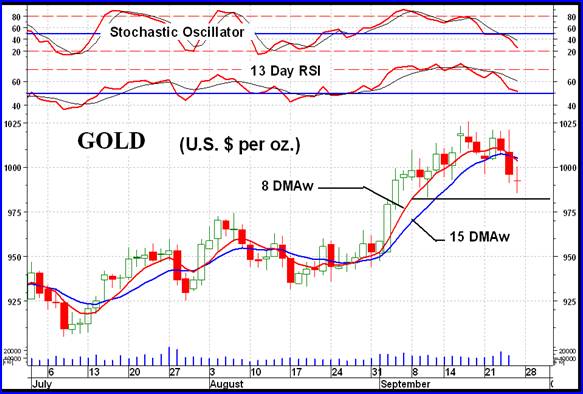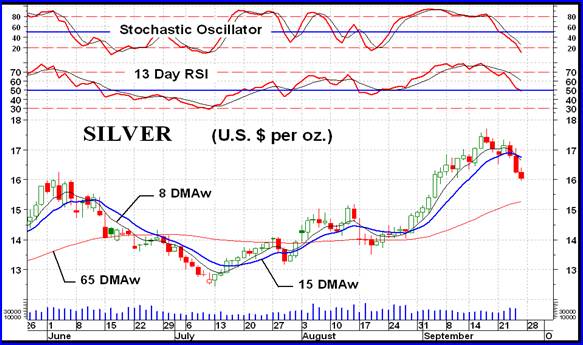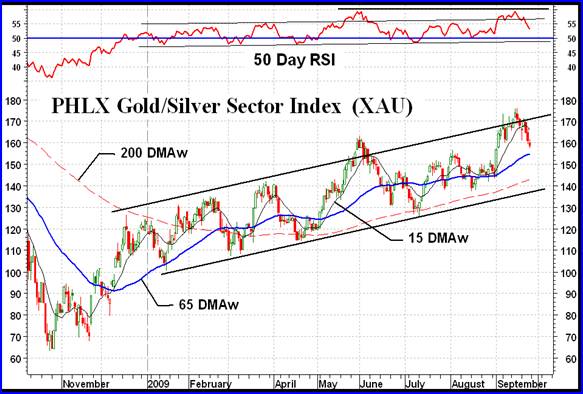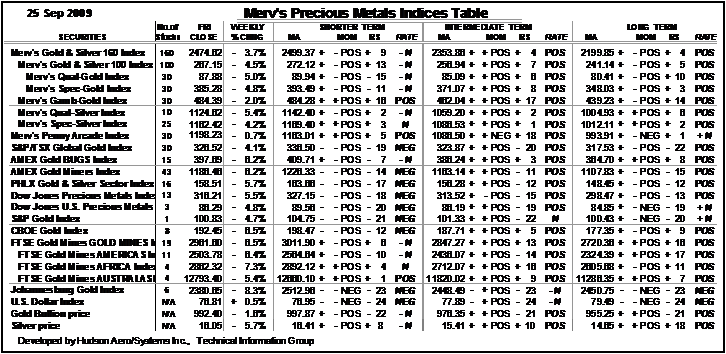Jason Hamlin, GoldStockBull.com Published 9/14/2009
Gold has finally breached the $1,000 level and looks like it might hold the line on this latest attempt. I anticipate that this psychologically-important level will turn from resistance into support as gold makes new highs towards the end of 2009. If I am correct, right now is the last chance investors will have to purchase gold for under $1,000/ounce.
A series of new and significant events have unfolded over the past few weeks that have influenced the precious metals markets and will likely continue to support gold’s price advance. If you are a gold investor, it is important that you understand these events and the impact they are likely to have on your investments.
Development #1 – China Encouraging Citizens to Buy Gold and Repatriating Gold Holdings from London
China is making a series of calculated decisions in order to mitigate the risk of a dollar collapse. They have already come out strongly and repeatedly in favor of a new reserve currency to compete with the dollar and have quietly been making large purchases to increase their gold reserves. But the Chinese government has taken it a step further this year. Financial Sense reports:
As recently as 2002, the private ownership of gold was prohibited in China. You could be jailed if caught with any in your possession. Beginning in 2009, in a stunning about-face, the central government removed all restrictions. In fact, as Mineweb and other sources report now it’s actively pushing folks to buy some personal metal, with China’s Central Television, the main state-owned television company, running news programs cum infomercials, letting the public know just how easy it is to purchase gold and silver as an investment.
It truly is as simple as can be, because every bank sells gold and silver bullion bars in four different sizes to individuals. (Try to find the same the next time you make the trek down to Wells Fargo.) Mining companies are reportedly encouraging employees to convert some of their wages to gold on payday. Gold is traded in some form 24 hours a day. And paper proxies for the metal are also soaring in popularity. There are persistent rumors that the export of silver has already been banned. Gold could be next.
Thus China, which only yesterday was the lowest per-capita consumer of gold in the world, is bidding to become the biggest. Some analysts believe it will pass India – the top dog since forever – as early as 2010. Clearly, the government believes the country is strengthened if everyone who can holds some hard currency.
All this suggests a mania in the making, and only in the formative stage. Imagine if hundreds of millions of new consumers climb on that particular bandwagon…
Indeed, if China’s newly formed middle class begins using even a small portion of their disposable incomes to purchase precious metals, a whole new source of demand will exert its influence on the gold markets.
In another brazen move, Hong Kong is pulling all its physical gold holdings from depositories in London, transferring them to a high-security depository newly built at the city’s airport. I believe that China demanding physical delivery of their gold will force the unwinding of derivatives and leases on the gold, tactics that many believe have been employed by Western governments in order to suppress the gold price. Some will go as far as to suggest that the physical gold may no longer be on hand in London. From my viewpoint, this transfer and demand for physical delivery can only be bullish for the gold price and beneficial to precious metals investors. As Jim Sinclair’s MineSet newsletter continually reminds investors:
“Nothing will unnerve the paper gold shorts more quickly and do more to undercut their confidence than to strip them of the real metal and force them to come up with more hard gold bullion to make good on deliveries. “Stand and Deliver or Go Home” should be the rallying cry of the gold longs to the paper gold shorts.” –Trader Dan Norcini
Development # 2 -The World’s Largest Gold Producer, Barrick Gold Corp, Announced a Decision to Close Its Massive Hedge Book
The world’s largest gold producer, Barrick Gold (NYSE: ABX), announced last Tuesday, Sept. 8, that it intends to pay off its entire book of fixed-price gold hedges and a portion of its floating hedges to gain greater exposure to the market price of gold. Barrick’s decision to close its 9.5 million ounce hedge book just as gold has taken out the $1,000 level speaks volumes. Instead of waiting for a correction and lower pricing, they are eager to gain full exposure to the gold price. What might the largest gold producer know about what is in store for the gold price and why the rush to de-hedge as gold is breaking $1,000? Forbes posed the same question:
It’s also another very strong signal from sophisticated operators who know the gold market best–gold mining company executives with the most on the line when they move from the certainty of having future production sold at locked-in rates to an environment in which their fortunes are fully leveraged to the price of gold.
In terms of scale and effect, Barrick’s move to de-hedge, the fixed price contracts alone (3 million ounces) are equivalent to reducing total annual global gold production for all gold producers by about 4 percent. The additional floating price hedges (6.5 million ounces) represent an additional 7% of annual global gold production for a grand total of 11% of annual global production. This is very bullish for gold going forward and a key reason the price closed last week above $1,000 an ounce, the highest end-of-week close ever.
Development # 3 – COMEX Commercial Traders Have Taken the Largest Net Short Position Against Gold & Silver Ever on Record
It is not unusual to see commercial traders go heavily short when gold makes a big run, but they have effectively gone “all in” this time with their total net short position setting a new record. These are presumably the most well-informed traders or “smart money.” While this news is usually very bearish and a preclude to a massive sell off, it is interesting to note that the commercial net short position increase was actually less than the increase in total open interest. In other words, despite taking record short positions against gold, they were unable to absorb all of the buying pressure. This is further evidenced by the fact that gold has held onto recent gains and continues hovering around the $1,000 mark.
I would not go so far as to say that gold investors are out of the woods quite yet. It will be interesting to see how the positions of commercial traders have changed over the past week. You can track the COT at this website: http://www.cftc.gov/marketreports/commitmentsoftraders/index.htm
My takeaway from this report, despite the record short position, is that the news is bullish for gold and could be the prelude to a huge move to the upside. If commercial shorts went so far as to establish a record net short position and still did not meet the increase in open interest, this suggests there is some very intense buying pressure on the other end. It may also suggest that many of the current gold buyers are demanding delivery of the physical metal and are no longer willing to accept a paper promise for future delivery. Which leads us into our fourth and final major development for precious metals…
Development # 4 – Gold and Silver Slipped into Backwardation Last Week
Both gold and silver slipped into backwardation last week. It was a light backwardation, but it is a relatively rare occurrence for precious metals and warrants our attention.
The term backwardation pops up every so often in the precious metals investment community and there is often confusion and misinformation around the topic. Backwardation exists when the price of a commodity for immediate delivery is higher than its price for delivery in the future. It can be interpreted to mean that people controlling the supply of monetary gold cannot be persuaded to part with it, regardless of the bait and suggests that there is more demand for immediate physical delivery than there is metal to service it.
Backwardation is usually viewed as a bullish sign for the underlying commodity. But to be fair, commodities go into backwardation for a variety of reasons and backwardation can last for quite some time and never lead to a breakdown of the delivery mechanism.
Still, with the news from China and signals that Russia and other countries are scrambling to increase their gold reserves, the current backwardation could be a very real sign of increased demand for physical delivery. This could blow the lid off what seems to be a long-standing attempt by issuers of fiat currency to suppress the price of gold and maintain their power structure. If more and more buyers begin demanding physical delivery, we could see the paper manipulation schemes unravel and a potential default of the COMEX. This could be the impetus for an explosion in prices for both gold and silver. I am not prophesying if and when this even will unfold, but simply calling attention to the possibility. For now, we will keep a closer watch on the degree of backwardation and continue to report as events unfold.
Any way that you look at it, we are entering intense times in the financial markets and a reality check for the monetary system that has brought great advantage to the United States since establishing the dollar as the world’s reserve currency. With the U.S. government creating an unfathomable amount of debt in a very condensed time period and China growing increasingly impatient, I believe it is only a matter of time before we experience a severe inflationary period. Those in power might be able to manufacture one last rally for the dollar and correction for gold, but each attempt seems to be dwindling it both its potency and stamina. The “banksters” are literally running out of arrows in their quiver. Reducing your exposure to the dollar and protecting your assets with a sensible allocation of gold and silver seems like an obvious move at this juncture.






![[Gold]](http://s.wsj.net/public/resources/images/OB-EM803_gold09_D_20090922101532.jpg) Bloomberg News
Bloomberg News 









